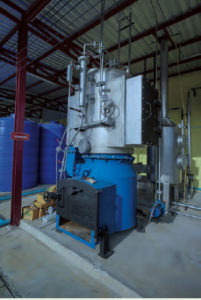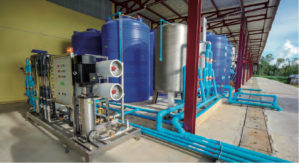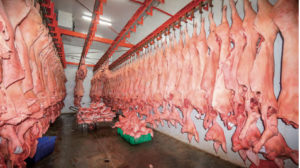Mu Inter Group has invested heavily to make MSP Inter Foods, its processing plant, a leader in consistent quality and smooth operations throughout the value chain.
The new plant with 500 head/shift capacity is the largest facility in Lampoon. GMP and HACCP accreditation is underway.
Live animal processing is done in compliance with Thailand’s Department of Livestock Development standards. The animals are sourced only from DLD- certified farms that use good agricultural practices and do not use beta-agonist drugs.
The plant’s overhead rail can accommodate live animals weighing up to 120 kg.

Wood fired boiler
The animals are treated humanely and trucked in from within a 150-km radius around the processing plant. Fasting period is at least six hours, including time spent in lairage where they have full access to water. Also, there is a separate pen for injured animals.
The animals are stunned with an electrical stunner and bled by severing the carotid artery and jugular vein. The stunning process has been fine-tuned to overcome meat quality issues, especially pale soft exudative (PSE) meat and muscle bruising.

Reverse osmosis water filtration unit
The animals are then left for bleeding, followed by dehairing in a scalding tank. A furnace burns off the remaining hair. Reverse osmosis treated water is used for carcass cleaning.
Entrails are removed and separated into red and white offal. The white offal – stomachs, intestines – are boiled and then submerged in cold water to reduce the temperature before packing and shipping. The red offal – hearts, livers, lungs – are processed and refrigerated. The low-risk zone is operated by 25 workers.
The carcass then moves to the high- risk area where it is split with a saw. Officials from the Department of Livestock Development are deployed on site for post-mortem inspection to ensure that the meat is safe and suitable for human consumption.

Blast freeze room
The carcasses are moved to a blast freezer for 3-4 hours to remove heat and minimize weight loss, and then stored in a cold room at 4°C for 24 hours for aging to improve tenderness.
There are 20 workers in the high-risk zone and dressing stations. In addition to standard dressing, customers, particularly food service clients, can order speci c cuts to meet their requirements.
The meat undergoes metal detection, with a special emphasis on broken needles which could injure consumers.
The dressed meat is delivered to customers and the company’s 45 outlets in Lampoon and nearby areas.
The plant’s wastewater treatment facility uses an anaerobic process. The system can accommodate up to 100 cubic metres/ day of water. The water is aerated and moved to ve treatment ponds, each of which can hold up to 3,200 cubic metres. The treated water is clean enough to use for washing vehicles and gardening.

